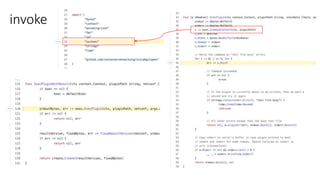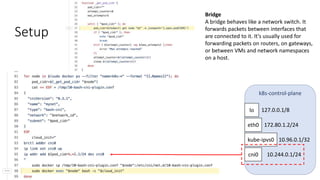Deciphering Kubernetes Networking
- 2. Victor Morales • +18 yrs as a Software Engineer • .NET, Java, python, Go programmer • OpenStack, OPNFV, ONAP and CNCF contributor. https://about.me/electrocucaracha
- 3. Main goal Understand the Containers Networking setup process during the creation of Pods in Kubernetes References: • https://www.altoros.com/blog/kubernetes-networking-writing-your-own-simple-cni-plug-in-with-bash/ • https://www.tkng.io/cni/ • https://sookocheff.com/post/kubernetes/understanding-kubernetes-networking-model/
- 4. Kubernetes (K8s) is an open-source system for automating deployment, scaling, and management of containerized applications.
- 5. Kubelet’s component architecture https://www.sobyte.net/post/2022-03/kubelet-pod-creation-workflow/ 1. Kubelet API 2. syncLoop layer (https://github.com/kubernetes/kubernetes/blob /v1.24.2/pkg/kubelet/kubelet.go#L1980-L2025 ) • PLEG • cAdvisor • PodWorkers • OOMWatcher • Container GC • Image GC • Managers 3. Container Runtime Interface
- 6. Kubelet workflow Syncs the running pod into the desired pod. 1. Compute sandbox and container changes 2. Kill pod sandbox if necessary 3. Kill any containers that should not be running 4. Create sandbox if necessary 5. Create ephemeral containers 6. Create init containers 7. Create normal containers https://github.com/kubernetes/kubernetes/blob/v1.24.2/pkg/kubelet/kuberuntime/kuberuntime_manager.go#L800 RunKubelet() Kubelet.RunOnce() ContainerRuntime.SyncPod() RuntimeService.RunPodSandbox()
- 7. ContainerD workflow RunPodSandbox() criService.setupPodNetwork() go-CNI.Setup() https://github.com/containerd/containerd/blob/v1.6.6/pkg/cri/server/sandbox_run.go#L59-L359 https://github.com/containerd/containerd/blob/v1.6.6/pkg/cri/server/sandbox_run.go#L376-L405 https://github.com/containerd/go-cni/blob/main/cni.go#L154-L168 cni.AddNetworkList() https://github.com/containernetworking/cni/blob/v1.1.1/libcni/api.go#L417-L433 CRI-O workflow RunPodSandbox() server.networkStart() ocicni.SetUpPodWithContext() https://github.com/cri-o/cri-o/blob/v1.24.1/server/sandbox_run.go#L65-L69 https://github.com/cri-o/cri-o/blob/v1.24.1/server/sandbox_network.go#L22-L129 https://github.com/cri-o/ocicni/blob/v0.4.0/pkg/ocicni/ocicni.go#L539-L574 cni.AddNetworkList() https://github.com/containernetworking/cni/blob/v1.1.1/libcni/api.go#L417-L433
- 8. libcni
- 9. invoke
- 10. https://github.com/cncf/artwork CNI (Container Network Interface), a Cloud Native Computing Foundation project, consists of a specification and libraries for writing plugins to configure network interfaces in Linux containers, along with a number of supported plugins. CNI concerns itself only with network connectivity of containers and removing allocated resources when the container is deleted.
- 13. CNI plugin written in BASH https://github.com/electrocucaracha/k8s-NetworkingDeepDive-demo/tree/master/bash
- 14. Setup Bridge A bridge behaves like a network switch. It forwards packets between interfaces that are connected to it. It's usually used for forwarding packets on routers, on gateways, or between VMs and network namespaces on a host. k8s-control-plane eth0 lo cni0 kube-ipvs0 127.0.0.1/8 172.80.1.2/24 10.96.0.1/32 10.244.0.1/24
- 15. Demo(ContainerD)
- 18. tmpCEE8 vethCEE8 VETH The VETH (virtual Ethernet) device is a local Ethernet tunnel. Devices are created in pairs, packets transmitted on one device in the pair are immediately received on the other device. These 2 devices can be imagined as being connected by a network cable.
- 23. Is that related with Neutron?
- 25. https://www.eficode.com/blog/debugging-kubernetes-networking Double-tunneling will have negative impact on data-plane performance (e.g. Kubernetes ‘flannel’ tunnel encapsulated in OpenStack ‘vxlan’ tunnel when running Kubernetes on top of OpenStack).
Editor's Notes
- Kubernetes is an open source platform for managing modern distributed applications. Unlike a traditional applications, distributed applications utilize multiple systems simultaneously and operate on the same network. In other words, distribution means that bits and bytes are moved from one process to another over a network. There are multiple components involved in the creation and configuration of the networking in Kubernetes. In this talk, we pretend to clarify this process through the creation of a CNI written in bash script which can help users to detect issues and facilitate their troubleshooting.
- PLEG: Call the container runtime interface to get the information of containers/sandboxes of this node, compare it with the locally maintained pod cache, generate the corresponding PodLifecycleEvent, and then send it to Kubelet syncLoop through eventChannel, and then synchronize the pod by the timing task to finally reach the desired state of the user. CAdvisor: A container monitoring tool integrated in Kubelet, used to collect monitoring information of this node and containers. PodWorkers: Multiple pod handlers are registered to handle pods at different times, including creation, update, deletion, etc. oomWatcher: Listener of system OOM, will establish SystemOOM with CAdvisor module, and generate events related to OOM signals received from CAdvisor by Watch. containerGC: responsible for cleaning up the useless containers on the node, the specific garbage collection operation is implemented by the container runtime. imageGC: Responsible for image recycling on node nodes. When the local disk space where the image is stored reaches a certain threshold, the image recycling will be triggered and the image not used by the pod will be deleted. Managers: Contains various managers that manage various resources related to pods. Each manager has its own role and works together in SyncLoop. https://github.com/kubernetes/kubernetes/blob/v1.24.2/pkg/kubelet/kubelet.go#L2027-L2172 configCh: The producer of this channel is provided by the PodConfig submodule in the kubeDeps object. This module will listen for changes in pod information from file, http, and apiserver, and will produce events to this channel once the pod information from a source is updated. plegCh: The producer of this channel is the pleg submodule, which will periodically query the container runtime for the current state of all containers, and if the state changes, it will produce events to this channel. syncCh: Sync the latest saved pod state periodically. livenessManager.Updates(): Health check finds that a pod is unavailable and the Kubelet will automatically perform the correct action based on the pod’s restartPolicy. houseKeepingCh: pipeline for housekeeping events, doing pod cleanup. When an ADD event occurs in configCh, the loop will trigger the HandlePodAdditions method of SyncHandler. https://github.com/kubernetes/kubernetes/blob/v1.24.2/pkg/kubelet/kubelet.go#L2212-L2250 https://github.com/kubernetes/kubernetes/blob/v1.24.2/pkg/kubelet/kubelet.go#L1455-L1737 https://github.com/kubernetes/kubernetes/blob/v1.24.2/pkg/kubelet/kuberuntime/kuberuntime_manager.go#L702-L940
- https://github.com/kubernetes/kubernetes/blob/v1.20.4/cmd/kubelet/app/server.go#L1170-L1173 https://github.com/kubernetes/kubernetes/blob/v1.20.4/pkg/kubelet/runonce.go#L61 https://github.com/kubernetes/kubernetes/blob/v1.20.4/pkg/kubelet/runonce.go#L83 https://github.com/kubernetes/kubernetes/blob/v1.20.4/pkg/kubelet/runonce.go#L133-L140 https://github.com/kubernetes/kubernetes/blob/v1.20.4/pkg/kubelet/kubelet.go#L1689 https://github.com/kubernetes/kubernetes/blob/v1.20.4/pkg/kubelet/kuberuntime/kuberuntime_manager.go#L666-L864 https://github.com/kubernetes/kubernetes/blob/v1.24.2/pkg/kubelet/kuberuntime/kuberuntime_manager.go#L800 https://github.com/kubernetes/kubernetes/blob/v1.24.2/pkg/kubelet/kuberuntime/kuberuntime_sandbox.go#L67 https://github.com/kubernetes/kubernetes/blob/v1.24.2/pkg/kubelet/cri/remote/remote_runtime.go#L194-L216
- https://github.com/containernetworking/cni/blob/v1.1.1/libcni/api.go#L422 https://github.com/containernetworking/cni/blob/v1.1.1/libcni/api.go#L414
- https://github.com/containernetworking/cni/blob/v1.1.1/pkg/invoke/exec.go#L120 https://github.com/containernetworking/cni/blob/v1.1.1/pkg/invoke/raw_exec.go#L45 https://pkg.go.dev/os/exec#Cmd.Run
- https://superuser.openstack.org/articles/run-your-kubernetes-cluster-on-openstack-in-production/


























